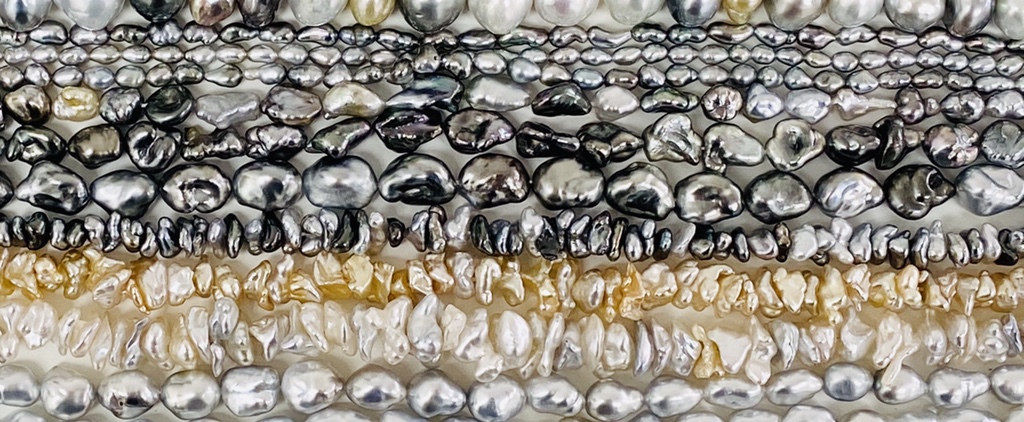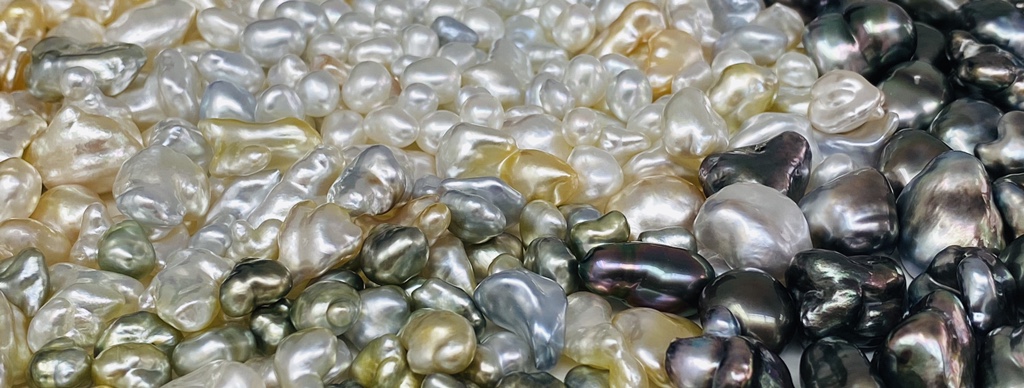South Sea and Tahitian Keshi Pearls
Keshi

The word Keshi is actually Japanese for “poppy seed,” which is also a reference to the pearls’ typically small size. Keshi pearls are small non-beaded pearls formed as by-products of pearl cultivation. They are formed when the oyster rejects and expels the implanted nucleus before the culturing process is complete, or the implanted mantle tissue fractures and forms separate pearl sacs without nuclei. Layers of nacre are secreted within the pearl sac, and without a nucleus, the resulting pearl is 100% nacre. This gives it an extraordinarily radiant luster and uncommon orient. In fact, most keshi have a greater luster than even that of the highest quality cultured pearls.
Keshi pearls may be solid nacre but they cannot be strictly categorized as natural pearls since human intervention played a role in their accidental formation. They are by-products of the culturing process, and not a natural occurrence.
It is important to note that keshi pearls are not a type of pearl but simply a type of pearl shape. At best, they can be considered a non-standard pearl variety owing to their unique formation. You can find keshi pearls in all the major pearl types, including Akoya, Tahitian, South Sea, and Freshwater.
Keshi pearls come in many unique and organic shapes. Since they are formed without a nucleus, shapes tend to be more baroque, with symmetrical ones being very rare. They abound in various hues, luster, colors and sizes. This versatility makes them stand out in different types of jewelry design. Keshi pearls are a treasure to have in any pearl lover’s jewelry wardrobe.


South Sea and Tahitian Keshi pearl strands
Nowadays, pearl farms are using x-ray on oysters to determine if an implantation was successful or not. When they discover an oyster with an expelled nucleus, it is re-nucleated before a keshi has time to form. This is causing keshi pearls to become increasingly rare, especially among Tahitian and South Sea pearls, due to advances in technology.
There are many reasons why pearl enthusiasts are enhancing their collection with keshi pearls. Here are the main ones:
- They are all-natural, consisting only of nacre.
- Being pure nacre, there is nothing to stop the reflection of light, and thus they are highly lustrous and have beautiful overtones. The many dents and bumps on the surface of the pearls further accentuate their luster.
- Their color and luster remain unchanged throughout time. This is one of the remarkable features of keshi.
- Keshi pearls also come in a range of free shapes, as their growth, without a nucleus, is random. Each keshi pearl is distinctive and unique in shape.
- They are becoming increasingly rare. The practice of interfering early on with their natural growth for more symmetrical shapes is depleting its market inventory.
- Their organic appeal inspires jewelry designs with modern, fun and very individualized look. These designs revamp the traditional view of pearl jewelry.

The colors and luster of Keshi pearls

